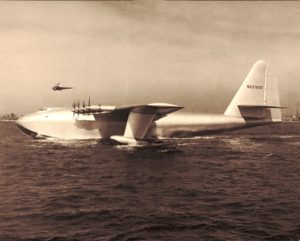Good morning, Whitewater.
Wednesday will bring scattered thunderstorms and a high of fifty-nine to Whitewater. Sunrise is 7:32 AM and sunset 5:44 PM, for 10h 12m 46s of daytime. The moon is a waxing crescent with 6.6% of its visible disk illuminated.
On this day in 1947, the Spruce Goose makes its only flight:
The Hughes H-4 Hercules (also known as the “Spruce Goose“; registration NX37602) is a prototype strategic airliftflying boat designed and built by the Hughes Aircraft Company. Intended as a transatlantic flight transport for use during World War II, it was not completed in time to be used in the war. The aircraft made only one brief flight on November 2, 1947, and the project never advanced beyond the single example produced. Built from wood because of wartime restrictions on the use of aluminium and concerns about weight, it was nicknamed by critics the “Spruce Goose”, although it was made almost entirely of birch.[2][3] The Hercules is the largest flying boat ever built and has the largest wingspan of any aircraft in history.[4] It remains in good condition and is on display at the Evergreen Aviation & Space Museum in McMinnville, Oregon, United States.[5]
….On November 2, 1947, the taxi tests began with Hughes at the controls. His crew included Dave Grant as copilot, two flight engineers, Don Smith and Joe Petrali, 16 mechanics, and two other flight crew. The H-4 also carried seven invited guests from the press corps and an additional seven industry representatives. Thirty-six were on board.[19]
Four reporters left to file stories after the first two taxi runs while the remaining press stayed for the final test run of the day.[20] After picking up speed on the channel facing Cabrillo Beach the Hercules lifted off, remaining airborne at 70 ft (21 m) off the water at a speed of 135 miles per hour (217 km/h) for about one mile (1.6 km).[21] At this altitude the aircraft still experienced ground effect.[22] The brief flight proved to detractors that Hughes’ (now unneeded) masterpiece was flight-worthy—thus vindicating the use of government funds.[23] The Spruce Goose, however, never flew again. Its lifting capacity and ceiling were never tested. A full-time crew of 300 workers, all sworn to secrecy, maintained the aircraft in flying condition in a climate-controlled hangar. The company reduced the crew to 50 workers in 1962 and then disbanded it after Hughes’ death in 1976.[24]
On this day in 1911, Wisconsin’s first vocational school opens.
Here’s JigZone‘s daily puzzle for Wednesday:

